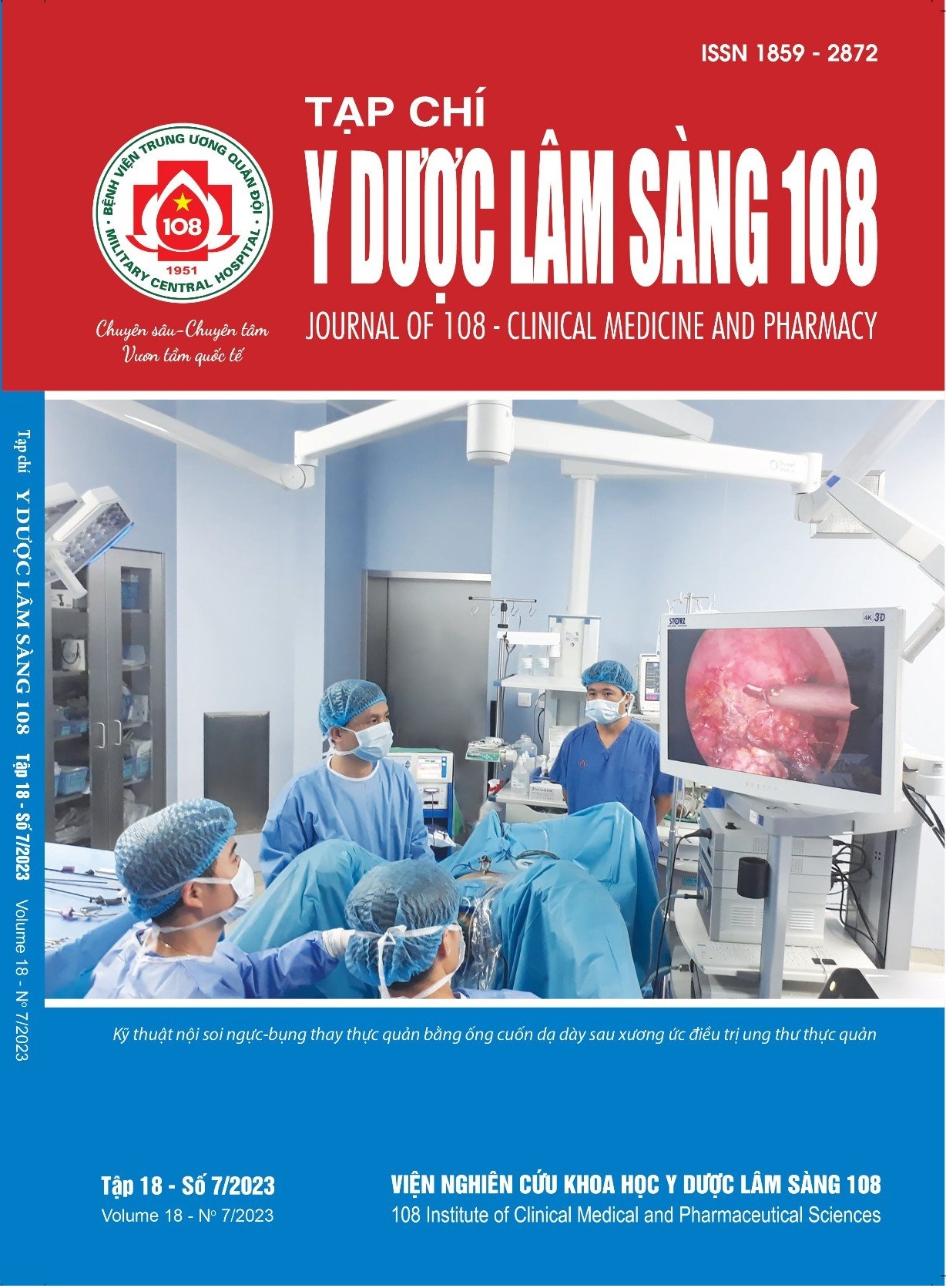Fusobacterium nucleatum là một trong những nguy cơ có thể gây ung thư đại trực tràng
Main Article Content
Keywords
Abstract
Objective: To determine the association between F. nucleatum and colorectal cancer. Subject and method: 192 patients with polyp or colorectal cancer at different stages treated at 108 Military Central Hospital from May 2017 to December 2020 were recruited into the current cross-sectional study. The infection rate and relative load of F. nucleatum were determined in colon tissues according to stages of infection by realtime PCR. Result: The infection rate of F. nucleatum in cancer colon tissue (76.3%) was 2 times higher than that in the polyp group (37.7%); whereas F. nucleatum infection rate in malignant tissues (69.8%) was higher than that in adjacent benign tissues (46%) in stage II of cancer (p<0.05). The relative load of F. nucleatum in stage III of cancer was higher than that in stages I and II of cancer, whereas the relative load of F. nucleatum in malignant tissues was higher than that in adjacent benign tissues in stages II and III of cancer (p<0.05). Colorectal cancer group had a 3.2 times higher risk of F. nucleatum infection than benign polyp group (CI 95%: 1.2-8.8, p=0.02). Conclusion: F. nucleatum may be one of the factors associated with the development of colorectal cancer.
Article Details
References
2. Collins D, Hogan AM, and Winter DC (2011) Microbial and viral pathogens in colorectal cancer. Lancet Oncol 12(5): 504-512.
3. Zur Hausen H (2009) The search for infectious causes of human cancers: Where and why. Virology 392(1): 1-10.
4. Sekirov I, Russell SL, Antunes LC, Finlay BB (2010) Gut microbiota in health and disease. Physiol Rev 90(3): 859-904.
5. Proctor LM (2011) The human microbiome project in 2011 and beyond. Cell Host Microbe 10(4): 287-291.
6. Elinav E, Nowarski R, Thaiss CA, Hu B, Jin C, Flavell RA (2013) Inflammation-induced cancer: crosstalk between tumours, immune cells and microorganisms. Nat Rev Cancer 13(11): 759-71.
7. Kostic AD, Chun E, Robertson L, Glickman JN, Gallini CA, Michaud M, Clancy TE, Chung DC, Lochhead P, Hold GL, El-Omar EM, Brenner D, Fuchs CS, Meyerson M, Garrett WS (2013) Fusobacterium nucleatum potentiates intestinal tumorigenesis and modulates the tumor-immune microenvironment. Cell Host Microbe 14(2): 207-215.
8. Yu T, Guo F, Yu Y, Sun T, Ma D, Han J, Qian Y, Kryczek I, Sun D, Nagarsheth N, Chen Y, Chen H, Hong J, Zou W, Fang JY (2017) Fusobacterium nucleatum promotes chemoresistance to colorectal cancer by modulating autophagy. Cell 170(3): 548-563.
9. Frederick M, Ausubel RB, Robert E Kingston, David D Moore, Seidman JG, John A Smith, and K.S. (eds.) (2003) Current Protocols in Molecular Biology. 66. John Wiley & Sons Inc.
10. Mima K, Sukawa Y, Nishihara R, Qian ZR, Yamauchi M, Inamura K, Kim SA, Masuda A, Nowak JA, Nosho K, Kostic AD, Giannakis M, Watanabe H, Bullman S, Milner DA, Harris CC, Giovannucci E, Garraway LA, Freeman GJ, Dranoff G, Chan AT, Garrett WS, Huttenhower C, Fuchs CS, Ogino S (2015) Fusobacterium nucleatum and T cells in colorectal carcinoma. JAMA Oncol 1(5): 653-661.
11. Sogin ML, Morrison HG, Huber JA, Mark Welch D, Huse SM, Neal PR, Arrieta JM, Herndl GJ (2006) Microbial diversity in the deep sea and the underexplored "rare biosphere". Proc Natl Acad Sci U S A 103(32): 12115-12120.
12. Bodenhausen N, Horton MW, and Bergelson J (2013) Bacterial communities associated with the leaves and the roots of Arabidopsis thaliana. PLoS One 8(2): 56329.
13. Wu YD, Chen LH, Wu XJ, Shang SQ, Lou JT, Du LZ, Zhao ZY (2008) Gram stain-specific-probe-based real-time PCR for diagnosis and discrimination of bacterial neonatal sepsis. J Clin Microbiol 46(8): 2613-2619.
14. Flanagan L, Schmid J, Ebert M, Soucek P, Kunicka T, Liska V, Bruha J, Neary P, Dezeeuw N, Tommasino M, Jenab M, Prehn JH, Hughes DJ (2014) Fusobacterium nucleatum associates with stages of colorectal neoplasia development, colorectal cancer and disease outcome. Eur J Clin Microbiol Infect Dis 33(8): 1381-1390.
15. Ito M, Kanno S, Nosho K, Sukawa Y, Mitsuhashi K, Kurihara H, Igarashi H, Takahashi T, Tachibana M, Takahashi H, Yoshii S, Takenouchi T, Hasegawa T, Okita K, Hirata K, Maruyama R, Suzuki H, Imai K, Yamamoto H, Shinomura Y (2015) Association of Fusobacterium nucleatum with clinical and molecular features in colorectal serrated pathway. Int J Cancer 137(6): 1258-1268.
16. Rubinstein MR, Wang X, Liu W, Hao Y, Cai G, Han YW (2013) Fusobacterium nucleatum promotes colorectal carcinogenesis by modulating E-cadherin/β-catenin signaling via its FadA adhesin. Cell Host Microbe 14(2): 195-206.
17. Abed J, Emgård JE, Zamir G, Faroja M, Almogy G, Grenov A, Sol A, Naor R, Pikarsky E, Atlan KA, Mellul A, Chaushu S, Manson AL, Earl AM, Ou N, Brennan CA, Garrett WS, Bachrach G (2016) Fap2 Mediates Fusobacterium nucleatum Colorectal Adenocarcinoma Enrichment by Binding to Tumor-Expressed Gal-GalNAc. Cell Host Microbe 20(2): 215-225.
 ISSN: 1859 - 2872
ISSN: 1859 - 2872
